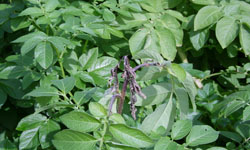
Successful potato blight control relies on using effective blight fungicides at appropriate times and spray intervals from crop emergence right through to harvest. In order to ensure complete and effective protection of the canopy, blight products must be rainfast and weather proof, especially if the weather is showery and when the majority of the crop is irrigated, says Dow AgroSciences.
"Farmers need blight fungicides that make the most of the spray days available and give them the best opportunity to keep to their planned spray intervals. In many circumstances when blight control falls down, it is often due to the lengthening of the spray interval, planned or otherwise. Farmers need to be confident that when they apply a blight fungicide, it stays on and in the plant and is not washed off. Based on zoxium and mancozeb, Electis has been proven in the laboratory and in the field to be a particularly rainfast fungicide," reports Andy Leader, Principal Biologist for Dow AgroSciences.
According to Andy, the rainfastness of Electis is largely due to the lipophilic nature of one of its actives, zoxium. "With low water solubility and high affinity for leaf wax, zoxium penetrates the potato leaf surface and moves rapidly into the waxy layers of the leaf, becoming rainfast within an hour and becoming highly resilient to wash off. In laboratory tests seven days after application, 27% of zoxium applied remained on the leaf surface, with a further 42% being in the leaf wax layers and the remaining 31% in the leaf cells. Fourteen days after application, the balance was 22% on the leaf surface, 34% on leaf wax layers and 44% in the leaf cells. By remaining in the waxy layers for such a long time, zoxium is only slowly metabolised in the plant, further enhancing the protective qualities of Electis."
Andy reports that glasshouse studies have confirmed Electis' excellent rainfastness. He explains that when a colossal 100 mm of rain was applied to potato plants 24 hours after spraying, no decline in blight activity was detected from the zoxium treatment compared to when no rain event took place. This was not the case for another protectant fungicide fluazinam that declined from 87% control with no rain to 66% blight control after rain.
"Field trials in the UK at AgriSearch have reinforced this result. In these trials 25 mm of irrigation water was applied 6 hours after the fungicide was applied and treated leaf samples were taken to be artificially inoculated with the blight pathogen and then incubated over a period of time. The Electis treatments showed a trace of blight after one day, 1% blight infection after three days, 5% after five days and only 7% after seven days. The untreated showed 68% infection at the final assessment under these highly intense experimental conditions," says Mr. Leader.
"Electis is a strong protectant fungicide that is best used from stable canopy onwards. In many years of successful commercial usage, it has shown excellent activity on both foliar and tuber blight and has been categorised as one of the top foliar blight fungicides as well as one of the best protectants by a panel of independent European industry experts. It is very effective against both foliar and tuber blight and is a highly suitable product to integrate into any blight programme, appearing to enhance the programme. Its high efficacy combined with one hour's rainfastness makes it a key team player in all blight control programmes, with good flexibility to suit irrigation regimes or to use in showery weather," concludes Andy.
